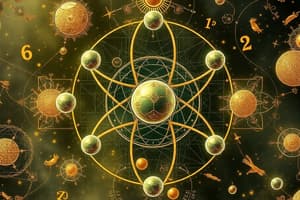Podcast
Questions and Answers
What does the secondary quantum number 'l' determine in an atom?
What does the secondary quantum number 'l' determine in an atom?
- The number of electrons in an orbital.
- The orientation of the atomic orbital in a magnetic field.
- The overall energy of the electron.
- The geometric shape of the atomic orbital. (correct)
For an electron in an s orbital, what is the value of the secondary quantum number 'l'?
For an electron in an s orbital, what is the value of the secondary quantum number 'l'?
- 0 (correct)
- 2
- 1
- 3
How many electrons can fit in a p orbital?
How many electrons can fit in a p orbital?
- 2
- 10
- 6 (correct)
- 12
What does the magnetic quantum number 'm' determine?
What does the magnetic quantum number 'm' determine?
What is the range of possible values for the spin quantum number 's'?
What is the range of possible values for the spin quantum number 's'?
Which rule is NOT part of the orbital filling rules?
Which rule is NOT part of the orbital filling rules?
What is true about the energy levels of hydrogen and hydrogen ions?
What is true about the energy levels of hydrogen and hydrogen ions?
How many values can the magnetic quantum number 'm' take for a given l value of 2?
How many values can the magnetic quantum number 'm' take for a given l value of 2?
What particles are found in the nucleus of an atom?
What particles are found in the nucleus of an atom?
What is the charge of a neutron?
What is the charge of a neutron?
What determines the atomic number of an element?
What determines the atomic number of an element?
Which particle has the smallest mass in an atom?
Which particle has the smallest mass in an atom?
What is the electric charge of a proton known as?
What is the electric charge of a proton known as?
If an atom is neutral, what can be said about the relationship between protons and electrons?
If an atom is neutral, what can be said about the relationship between protons and electrons?
What is the charge of an electron?
What is the charge of an electron?
What is the approximate mass of a proton?
What is the approximate mass of a proton?
What does the mass number (A) of an atom represent?
What does the mass number (A) of an atom represent?
What is represented by Z in the context of an atom?
What is represented by Z in the context of an atom?
Which equation shows the relationship between mass number (A), atomic number (Z), and the number of neutrons (N)?
Which equation shows the relationship between mass number (A), atomic number (Z), and the number of neutrons (N)?
How is the atomic molar mass of an element expressed?
How is the atomic molar mass of an element expressed?
What component of an atom constitutes the majority of its mass?
What component of an atom constitutes the majority of its mass?
What is the mass defect in relation to an atomic nucleus?
What is the mass defect in relation to an atomic nucleus?
Which constant describes the number of elementary entities in one mole?
Which constant describes the number of elementary entities in one mole?
How is the molar mass of a molecule calculated?
How is the molar mass of a molecule calculated?
What is the approximate number of carbon atoms contained in 12 grams of carbon 12?
What is the approximate number of carbon atoms contained in 12 grams of carbon 12?
What does the unit u.m.a stand for, and how much does it equal in kilograms?
What does the unit u.m.a stand for, and how much does it equal in kilograms?
How are isotopes defined?
How are isotopes defined?
What does the average atomic mass of an element take into account?
What does the average atomic mass of an element take into account?
What does a negative value for E indicate in nucleus formation?
What does a negative value for E indicate in nucleus formation?
What concept did Bohr's theory fail to explain?
What concept did Bohr's theory fail to explain?
What is the significance of Δm in nuclear formation?
What is the significance of Δm in nuclear formation?
What does the term 'mass defect' refer to?
What does the term 'mass defect' refer to?
What does Broglie's hypothesis propose about the nature of particles?
What does Broglie's hypothesis propose about the nature of particles?
What does the Heisenberg uncertainty principle state about particles?
What does the Heisenberg uncertainty principle state about particles?
What does the Schrödinger equation fundamentally describe?
What does the Schrödinger equation fundamentally describe?
What is represented by the wave function Ψ in quantum mechanics?
What is represented by the wave function Ψ in quantum mechanics?
What is the main quantum number 'n' used to indicate?
What is the main quantum number 'n' used to indicate?
According to the wave-particle duality, what is associated with the wavelength (λ) of a particle?
According to the wave-particle duality, what is associated with the wavelength (λ) of a particle?
Which relationship does the equation Δx × Δp ≥ ℏ illustrate?
Which relationship does the equation Δx × Δp ≥ ℏ illustrate?
What is Δv in the context of the Heisenberg uncertainty principle?
What is Δv in the context of the Heisenberg uncertainty principle?
Study Notes
Quantum Numbers
- The secondary quantum number (l), represents the shape of an electron's orbital.
- It can take integer values from 0 to n-1, where n is the principal quantum number.
- l= 0 is an s orbital (spherical)
- l = 1 is a p orbital (dumbbell)
- l = 2 is a d orbital (complex shapes)
- l = 3 is an f orbital (complex shapes)
- The magnetic quantum number (m), quantifies the spatial orientation of an orbital in a magnetic field.
- It can take integer values from -l to +l, including 0.
- The spin quantum number (s), describes the intrinsic angular momentum of an electron, also known as spin.
- It can have two values: +1/2 (spin-up) or -1/2 (spin-down).
Atomic Structure
- An atom is the basic unit of matter, consisting of a dense nucleus surrounded by a cloud of negatively charged electrons.
- The nucleus contains positively charged protons and neutral neutrons.
- The atom is characterized by its atomic number (Z) and mass number (A).
- The atomic number (Z), represents the number of protons in the nucleus. This defines the element.
- In a neutral atom, the number of protons is equal to the number of electrons.
- The **mass number (A) **, is the total number of protons and neutrons in the nucleus.
- A = Z + N, where N is the number of neutrons.
- Isotopes are atoms of the same element that have the same atomic number (Z) but different mass numbers (A) due to a different number of neutrons.
- Different isotopes of an element have the same chemical properties but different physical properties.
Quantum Mechanics
- The Schrödinger equation is a fundamental equation in quantum mechanics that describes the behavior of electrons in atoms.
- It predicts the probability of finding an electron at a specific point in space.
- The solutions to the Schrödinger equation provide information about four quantum numbers for an electron:
- n, l, m, and s.
Filling Rules and Electronic Configurations
- Klechkovsky's rule dictates the order in which electron orbitals are filled.
- Electrons are placed in orbitals in order of increasing energy.
- The Pauli exclusion principle states that no two electrons in an atom can have the same four quantum numbers.
- Hund's rule states that electrons will individually occupy orbitals within a subshell before double occupancy occurs.
- This maximizes the number of unpaired electrons with parallel spins.
Bohr's Model and Quantum Mechanics
- Bohr's model was a successful model for hydrogen and hydrogenoid atoms but failed to explain the spectra of multi-electron atoms.
- This was because Bohr didn't account for electron-electron and electron-nucleus interactions.
- Quantum mechanics was developed to address limitations of Bohr's model and provide a more accurate description of atomic structure.
- Quantum mechanics involves probabilities rather than definite locations for electrons.
Broglie Hypothesis
- De Broglie's hypothesis proposed wave-particle duality for all matter.
- It postulates a wave nature for all objects with momentum, not just light.
Heisenberg Uncertainty Principle
- Heisenberg's uncertainty principle states that it is impossible to precisely determine both the position and momentum of a particle simultaneously.
- The more precisely a particle's position is known, the less precisely its momentum can be known.
Studying That Suits You
Use AI to generate personalized quizzes and flashcards to suit your learning preferences.
Related Documents
Description
This quiz explores the concepts of quantum numbers and their role in atomic structure. You'll learn about the secondary quantum number, magnetic quantum number, and spin quantum number, as well as the basic characteristics of atoms. Test your understanding of these fundamental topics in chemistry.




